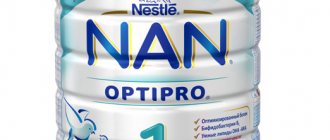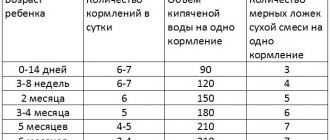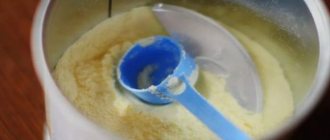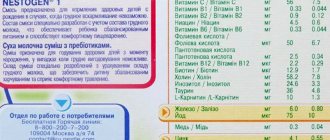WHO recommendations
According to WHO recommendations, breastfeeding is vital for a child of 1 year of life. The recommendations for feeding with adapted milk formulas are similar.
Thus, if the baby does not receive breast milk. Until the age of 1 year, pediatricians from all over the world recommend feeding him with adapted milk formulas. With the gradual introduction of complementary foods, according to age recommendations. Cow's milk and fermented milk products are recommended to be included in the baby's menu after one year. But it is allowed for economic reasons (in those families where there is not enough money for formula) from 8 months.
In our city, adapted milk formulas are prescribed free of charge for children from low-income and large families only up to 1 year of age. In the 2nd year of life they are prescribed fermented milk products: Narine and Bifidok.
It turns out that after one year there is no need to feed the child with an adapted milk formula? But each of the manufacturers of infant formula has formulas for feeding children after one year. What are they needed for ?
What does WHO think about infant formula after one year?
WHO recommends feeding a child with breast milk or adaptive formula until 1 year of age if breastfeeding is not possible. The first complementary foods are introduced to breastfed children from 6 months, and from 4 months to bottle-fed children. It is recommended to include cow and goat milk, as well as fermented milk products, in a child’s diet no earlier than 8 months. After one year, there are no specific WHO guidelines regarding infant formula from one year onwards. Thus, it turns out that after 1 year you can do without adaptive milk formulas, but on store shelves we find a variety of formulas after a year for children. So why are they needed?
Regular food
Proper nutrition of children aged 1 to 3 years is currently being actively studied by pediatric nutritionists. In this case it becomes clear. That children of this age need protein is lower than the average modern children receive with a normal diet (a common table, with the exception of fatty, fried, spicy, salty foods). In addition, such children need PUFAs: linoleic, linolenic and LCPUFAs: docosocexaenoic acid, eicosapentaenoic acid. Which take part in the formation of the baby’s nervous system. Children under 3 years of age do not receive enough iron, calcium, vitamins, etc. from their diet.
The advantage of formula after a year over regular milk
If a child’s diet after 1 year includes 200 ml of infant formula instead of cow’s milk, then he will receive per day:
- 20-35% less fat and protein;
- 50% more vitamin A;
- 5 times more iron;
- more calcium and magnesium;
— a sufficient amount of essential amino acids omega 3 and omega 6;
- required amount of vitamin D;
- prebiotics and probiotics.
The mixture is easier to digest and does not cause gas formation. It is sterile and must undergo quality control, and cow's milk, if it is not intended for children under 3 years of age, is not always of good quality and may contain antibiotics and other substances that extend shelf life.
Infant formula after one year
Infant formula after one year is a product specially adapted to the needs of children from 1 to 3 years old.
Compound
This mixture contains 25-30% less protein than cow's milk. Saturated milk fat is replaced with vegetable fat, as a result the child’s need for PUFAs and LC PUFAs (omega 3 and omega 6) is satisfied.
Formulas for children after one year of age contain prebiotics. Which serve as a breeding ground for the growth of normal intestinal microflora and prevent constipation. Some mixtures have added probiotics. Pre and probiotics form normal intestinal microflora. They affect the child’s immunity, which is very important for a baby of the 2nd and 3rd year of life. Whose contact with the environment increases and the risk of developing infections increases.
The mixtures are enriched with minerals, vitamins and vitamin-like substances that the child needs. They contain vitamin E, inositol, zinc, beta-carotene, manganese. For the growth of a child, there are the necessary vitamins A and D. And the optimal ratio in the mixture of calcium and phosphorus is maintained.
To prevent iron deficiency anemia, the mixtures contain iron, zinc, copper and vitamin C in optimal proportions.
What do they give the child?
Including only 200 ml of formula (instead of cow's milk) in the menu of a child of the 2nd year of life allows the baby to receive per day:
- twice as much vitamin A,
- 5 times more iron,
- a little more calcium
- but less protein and fat.
It is very important that with an adapted milk formula the baby receives vitamin D and unsaturated fatty acids. Which, as a rule, enter the body in insufficient quantities.
Range
Formulas for feeding a healthy child from 1 to 3 years old are designated by the number 3. There are a huge number of them on the market. Malyutka 3, Nutrilon 3, Nan optipro 3, Nestozhen 3, Frisolak 3, Frisolak Gold 3, Bellakt 3, Bellakt Optimum 3, Nutrilac 3, Nutrilac premium 3.
There are also mixtures with the number 4. You need to carefully read the instructions for them. Because Nestozhen 4, Nutrilon 4 and Malyutka 4 are mixtures for children from 1.5 years old. And Frisolak Gold 4 is a mixture for children from 3 to 10 years old.
Composition of infant formula after one year
The protein content in infant formula after one year is 25-30% less than in regular cow's milk.
Infant formulas for children after one year of age include vegetable fats rich in omega 3 and omega 6. These essential amino acids are needed for the development of the nervous system, vision and immunity.
Amino acids such as taurine and tryptophan strengthen the nervous system, normalize sleep and improve the child’s mood.
Nucleotides included in infant formula for children after one year of age improve intestinal function.
The phospholipids included in the composition, and in particular lecithin, are involved in lipid metabolism and help remove “bad cholesterol” from the body.
The formula for children after one year of age includes split carbohydrates into lactose and maltodextrin, which reduce gas formation in the intestines, but at the same time give the mixture a sweetish taste.
Prebiotics - inulin, galacto- and fructo-oligosaccharides, help normalize digestive processes by increasing the growth of beneficial intestinal bacteria and promote the absorption of calcium and magnesium.
After one year of age, infant formula contains probiotics. These are living microorganisms that help digest food in the intestines.
Prebiotics and probiotics are very important for the child’s body, as they form normal intestinal microflora and strengthen the immune system. Their use is a good prevention of constipation, dysbiosis and infectious diseases.
All formulas after one year are enriched with vitamins and minerals required by age standards for children (vitamins A, E, D, B1, inositol, selenium, beta-carotene, manganese, optimal ratio of calcium and phosphorus).
To prevent iron deficiency anemia, infant formulas up to one year old include iron, zinc, copper and vitamin C in optimal concentrations.
What types of dry mixes are there?
Experts advise newborns to choose only dry adapted milk formulas - their composition is as close as possible to breast milk, and is also easily digested and absorbed by babies.
If a child has any health problems, the pediatrician may recommend medicinal or specialized mixtures:
- with special thickeners (starch) - if the baby has flatulence and frequent regurgitation;
- with probiotics and prebiotics - in case of constipation and dysbiosis;
- with the so-called “night formula” - if the baby has problems sleeping;
- from highly hydrolyzed proteins based on whey and casein - if the baby is allergic to cow's milk protein.
Article on the topicEternal baby. After what age should a child not be breastfed?
What mixtures are there after a year?
Formulas for feeding children from 1 year to 3 years old are labeled 3. Tasty sweet natural ingredients are added to some mixtures so that babies eat them with pleasure. These infant formulas include:
• “Baby 3”; • “Baby 3” • “Humana 3” • “Nestozhen 3”; • "Nutrilon 3"; • "Nan optipro 3"; • "Similac 3"; • "Friso Junior 3"; • "Friso Gold 3"; • "Nutrilak 3"; • “Nutrilak Premium 3”; • "Bellakt 3"; • "Bellakt Optimum 3".
Also on store shelves you can see mixtures labeled 4, they are intended from 18 months or even older, for example, from 3 years. Before purchasing such a mixture, you need to pay attention to the indicated age.
From 1.5 years:
• “Baby 4”; • “Nestozhen 4”; • "Nutrilon 4"; • "Nan optipro 4"; • "Similac 4".
From 3 years:
• "Friso Gold 4".
The composition of such mixtures
The composition of almost all infant formula for feeding after one year is identical.
They may differ only in individual positions, as well as in the amount of certain substances:
- Taurine or tryptophan. They have a beneficial effect on the development of the baby’s liver and central nervous system, helping to optimize waking time.
- Nucleotides. They participate in many body processes, including promoting improved intestinal function.
- Omega-3, Omega-6. They have a positive effect on brain development, immunity, vision, and the nervous system. They help in the fight against allergies and inflammation, promote the normal functioning of the circulatory system, and regulate cholesterol levels.
- Palm oil. Included in almost all infant formulas from one year onwards. In moderation, it aids in the absorption of vitamins and is also a source of some saturated fatty acids, which provide energy to a growing body.
- Lecithin. Simplifies the absorption of fats and removes them from the body in a timely manner. Has a beneficial effect on the functioning of the liver and nervous system.
- Lactose, maltodextrin. They replace sugar, making the mixture sweet, and combat gas formation.
- Probiotics. These are microorganisms that are necessary for the proper functioning of the gastrointestinal tract.
- Galacto- and fructo-oligosaccharides, inulin. Promote the growth of the number of bacteria responsible for normalizing stool and promoting the absorption of calcium and magnesium. They also have a positive effect on the development of the nervous system.
- A number of antioxidants (selenium, carotenoids, manganese, zinc, vitamins C and E) work to protect the body from external influences. They improve memory, promote the proper development of the genitourinary system and the restoration of new cells, have a beneficial effect on the central nervous system, metabolism, vision, skin, immunity, regulate blood clotting, and strengthen blood vessels.
Features of milk formulas for children over one year old
All modern manufacturers of baby food make age markings for formulas: number 1 is suitable for feeding from birth to 6 months, 2 - from six months to a year, and then there are 3rd and 4th positions.
All these divisions were not invented in vain: at different stages of development, a growing organism has different needs, and it would be a big mistake to continue to give the mixture labeled 2 after a year.
It is from the third stage mixture that the child receives most of the necessary vitamins, since ordinary products are not able to provide the body with useful substances. In addition, infant formula can partially satisfy a child’s need for fermented milk products.
The food of the third stage differs from the previous ones in its composition:
- The amount of vitamins and minerals is increased according to the body's needs. That is, one portion of the mixture labeled 3 will contain more useful substances than the same portion labeled 2.
- There is more casein. This leads to an increase in the calorie content of the product, which is necessary for an actively moving child. In addition, casein is absorbed quite slowly, so the feeling of fullness remains for a long time.
- The taste changes: it becomes more similar to classic food.
Types of medicinal mixtures after a year
Various brands of baby food produce special baby formulas with preventive and therapeutic effects for children under 1 year of age and after.
Goat milk formulas after one year
Goat milk formulas include the following brands:
• "Nenny 3"; • "Cabrita 3"; • “MD Mil goat 3”; • "Mamako 3". • "Mamako Premium 3".
Goat milk formulas are given to children with intolerance to cow protein or at the request of the parents.
Fermented milk mixtures after one year
• “Nan Fermented Milk 3”; • "Bellakt KM 3".
Fermented milk mixtures are indicated for children with bowel problems, previous intestinal infections, and iron deficiency.
Mixtures that increase a child's immunity
• "Bellakt Immunis 3".
Contains bifidobacteria, which normalize intestinal function and treat dysbacteriosis.
Preventive formulas for children prone to food allergies
• “Nan hypoallergenic 3”; • “Humana hypoallergenic 3”.
These mixtures are given to children at risk for food allergies.
Therapeutic mixtures for children with food allergies
• "Peptamen Junior"; • Neocate Advance.
Hypoallergenic formulas are given to children with moderate and severe forms of food allergies. They contain protein hydrolyzate or completely broken down protein into amino acids.
Formulas for children after one year of age with underweight and poor appetite
• “Pediashur Maloyezhka”; • "Clinutren Junior".
For children under one year old, there are special formulas for premature and low birth weight babies with a high content of proteins, fats and carbohydrates. For children after one year, there are also such mixtures in the form of delicious cocktails. They are usually prescribed for children who do not eat regular food well or for malnourished children after illness.











